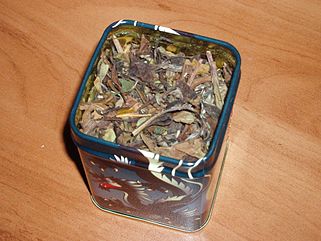Shou Mei
Shou Mei (Simplified Chinese: 寿眉; Traditional Chinese: 壽眉; Pinyin: Shòu méi; Cantonese Yale: Sauh méi; Standard Chinese pronunciation [ʂôu̯.měi̯]) is a white tea made from naturally withered upper leaves and tips and has a stronger aroma reminiscent of lighter oolong teas.
"Shou" stands for "long life" and "Mei" for "eyebrow" - that is, "Long Life Eyebrow Tea", from which the tea got its English name "Long Life Eyebrow Tea" or "Noble". Shou Mei got its Chinese name from the appearance of the tea leaves after the infusion, which are reminiscent of eyebrows.
Taste, smell and color
Shou Mei is made from the Camellia Sinensis tea plant (like all white teas too). White teas differ from the other teas through the use of special Camellia Sinensis varieties, mostly the Da Bai and Da Hao shrubs, and the low processing of the tea; that is, it is not heated, baked or steamed. Because the white tea remains natural, it has a special taste and effect.
The taste of Shou Mei is both intense and round and smooth with a fresh aroma. Good Shou Mei has a sweetness and bitterness at the same time. If the tea tastes mostly bitter and somewhat astringent, its quality is rated as less good. Shou Mei is easy to enjoy for tea beginners and is reminiscent of light oolong teas. The color of the infusion is a beautiful golden yellow to orange.
Cultivation and maturity
Shou Mei is mainly in the provinces of Fujian and Guangxi in China grown. Since this tea is picked later than Bai Mudan , the tea can be darker in color, but should still retain its relatively green color. Some lower quality Shou Mei may be golden in color, with lots of black and red leaves, making for a darker brew with more depth.
Shou Mei matures for several years and is very popular because it develops a particularly intense aroma and a high health effect during the ripening period. As with the silver needle and Bai Mudan , well-ripened Shou Mei is viewed as a special delicacy and is accordingly offered at a high price.
In terms of quality, Shou Mei tea is a fourth class tea, uses Da Bai or large white leaves, and is a by-product of Baihao Yinzhen tea production.
Since Shou Mei is harvested later than other white teas and only the oldest and coarsest white leaves are used to make it, it is often viewed as a by-product of silver needle and Bai Mudan tea. In terms of quality, Shou Mei is considered the lowest of the four main types of white tea.
Taste and preparation
The tea can be brewed in very different ways, resulting in many combinations with interesting results. However, it is important, on the one hand, to use good water to bring out the sweetness and aroma of the tea and, on the other hand, not to brew too much so as not to make a bitter and very strong tea. A recommendation is to prepare Shou Mei like Bai Mudan, i.e. let it steep for three minutes at a water temperature of 80 ° C.
Typically, white teas are brewed at a lower temperature than black teas. Often temperatures around 70 degrees Celsius are enough. Different steeping times and temperatures result in a remarkably different effect on the final brew. For the western brewing method, a time of two to five minutes is ideal if the tea is prepared in a glass or in a western teapot . However, if a gaiwan bowl or yixing teapot is used in the gong-fu type of brewing, which contains large amounts of the leaf and smaller amounts of water to be shared among tea drinkers, brewing times of less than a minute (sometimes even measured in seconds) preferred.
See also
Bibliography
- Master Lam Kam Cheun et al, The way of tea, Gaia Books, 2002, ISBN 1-85675-143-0 .
- Christopher Roberson, White tea (China) from Usenet's rec.food.drink.tea, FAQ, via pages.ripco.net, 2000.
Web links
Individual evidence
- ↑ a b c d e f g Shou Mei White Tea Cake ( page no longer available , search in web archives ) Info: The link was automatically marked as defective. Please check the link according to the instructions and then remove this notice. , Vicony Teas Company, accessed November 12, 2016
- ↑ a b c d e SHOU MEI (WHITE TEA) , weisser.tee.net, accessed on November 12, 2016
